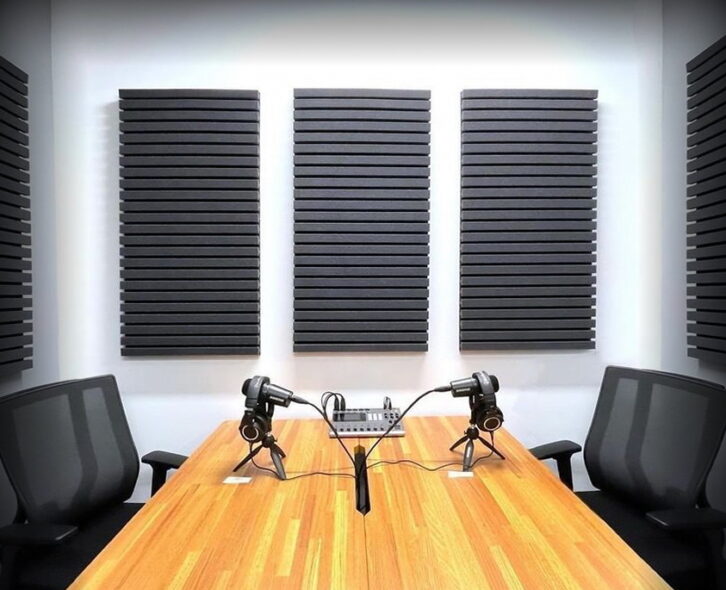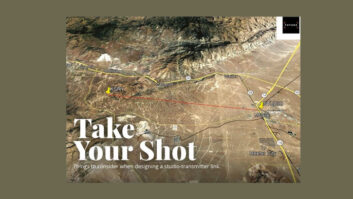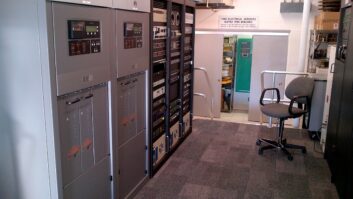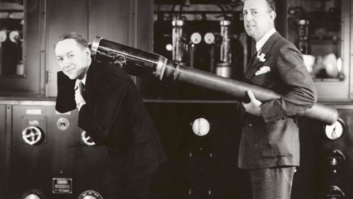In the beginning there was perfect sound. Then man invented rooms.
I’m Eric Smith, founder and president of Auralex, the 46-year-old global acoustical products and consulting company. I’ve have been asked to write a series on acoustics and sound-related construction concerns for radio environments.
I know firsthand the acoustics and sound-isolation issues that often plague air and production studios. I not only wear an acoustical consultant hat but I worked at top radio stations in multiple markets in the ’70s, ’80s and ’90s as an air personality, production director, fill-in talkshow host, producer and more. I appreciate the opportunity to pay forward some of my accumulated knowledge.
I’ll talk about room acoustics and products and methods that can make a space sound better, in-room and on-air, as well as how to construct sound-critical spaces and address common issues such as HVAC noise, sound leakage and more. There’s a lot of false information out there, so my job is to give you lab-verified, time-tested knowledge to build or treat your spaces in the fastest, least involved and least expensive ways possible.
The two modalities of acoustical optimization — in-room treatment and sound isolation — work synergistically. Either can help you, but when used together, 1+1 can equal 3. Plus, a properly constructed space inherently sounds better, doing some of the acoustical heavy lifting for you.
The document that inspires this series is my Auralex booklet “Acoustics 101,” which you can download for free as a PDF, and which a number of notable people have called their studio-construction bible. Feel free to refer to it as well as my ever-expanding companion document “Real-World Acoustics.”
Regardless of format or content, Job One in radio should be to put out quality audio. Unfortunately, whether from DJs, newspeople, traffic reporters or talk-radio hosts, and whether in-studio, remote or a work-from-home voice-tracking setup, poor acoustics often degrade audio quality by generating excessive room-tone noise. This screams “unprofessional” and distracts the listener from bonding with the content.
With so many platforms vying for their attention, and with listeners often consuming our content while driving, working, studying, cleaning house, etc., it’s critically important to put out clean audio that doesn’t tax the person by causing their ear-brain mechanism to work hard to separate important audio content from noise introduced by poor acoustics.
When their brains have to devote “CPU cycles” to separating the aural chaff from the wheat, listeners aren’t drawn in by the content being conveyed. We lose them. No one wants to tucker out from struggling to decipher our content.
In addition, air-chain processing can accentuate excessive room ambience, so we must start with as clean an audio signal as possible. Compression pulls up the ambience and noise-gating can sound unnatural when used with an excessively ambient space. Phil Collins drum-sound, anyone?
Listener vs. mic vs. talent
We care about how the listener perceives our content. But the way we convey that content is via one or more microphones, some of which don’t have as tight a pickup pattern as needed to reject off-axis room ambience. As such, we need to build sufficiently sound-isolated facilities and implement a sufficient degree of, and proper type of, acoustical treatment in our studios so that the microphone conveys the cleanest possible spoken or performed audio.
We also have to remain cognizant of how the talent (solo or group) perceives the degree of sound isolation and the in-room acoustics. We need to balance what the mic hears with what the talent hears; the acoustics must be transparent to the talent and not distract them or keep them from performing their best. Further, in a group, they need to be able to hear each other well to facilitate seamless interaction. And, with multiple mics open at once, poor in-room acoustics can really trash your audio.
No talent wants to pot open a mic and hear a version of their voice that sounds as if they’re in a cave. Everyone wants to sound tight, present and authoritative, but that will simply not occur in an insufficiently controlled environment — be it in your facility, a home studio or a remote environment such as a client’s office. We want listeners to hear voices that emanate from a dead-silent background.
For example, when the late legend Don LaFontaine was voicing movie trailers in his Auralex-treated studio, you heard his magnificent voice come from a black, noiseless place, thus allowing his nuance to create the best possible emotional connection with the listener.
I gave a lecture on acoustics at the Don LaFontaine VO Lab in the SAG building in Los Angeles. In the talk, I stated that if Mr. LaFontaine had said his trademark “In a World …” in the highly reverberant hallway that leads to the lab instead of in his well-designed studio, his trailers wouldn’t have been nearly as successful. This concept applies to your audio, too.
I once worked as the production director at a 50 kW market-leading station where the production room was large and insufficiently treated, and I went round and round with management over the need for acoustical treatment. Spots that I and the air talent cut were far too ambient, which I felt undermined the station’s credibility in the minds of the listeners.

[Check Out More of Radio World’s Tech Tips]
Invisible enemy
With our acoustical treatments and construction, we’re working to control room modes, which are reflection patterns, based on physics, that cause peaks or dips (cancellations) in the frequency response of the room. There are three types of modes: axial (between two surfaces), tangential (touching four surfaces) and oblique (touching six surfaces). Axial are the strongest and most offensive.
Now, given today’s glass-everywhere air-studio designs, there’s often a limit to what acoustical treatments we can implement, and where. Production rooms tend to have less glass, so we can generally do a better job of treating their boundaries properly. In the world-class recording studios we at Auralex design for the biggest names you can imagine, we implement physical and acoustical symmetry, whereas that’s often impossible in a radio air-studio. Thus, we have to work smarter, not harder, and seek the maximum amount of control out of the space that’s available for treatment. But fear not; the cavalry is coming.
In work-from-home voice-tracking environments, we generally have better access to the areas where acoustical treatments can be most effective, but sometimes stand-mounted treatments are called for due to room layout, windows, doors, trimwork, etc. Home studio environments have gained prominence in the pandemic era, and the stand-mounted portable treatments they often require can in some ways be even more effective than boundary-mounted treatments. These voice-tracking environments may not be purpose-built, so we often also consult on how to best shore up the construction for maximum sound isolation with the least amount of disruption, work or expense. Don’t fret, though; there’s always something that can be done to improve a space’s sound isolation and acoustics.
Tools of the trade
Let’s hit some basics on which we can build (literally).
Sound can be absorbed, reflected or blocked. It can also be attenuated by physically isolating one thing from another; this is sort of a subset of the “blocked” category and we’ll dig into this in the series, as this method can sometimes be enormously beneficial and less expensive to implement than other modalities.
When I refer to isolating things from each other, I’ll sometimes mention “floating” them, which means that we’re keeping one thing from contacting another, thus attenuating the frequencies we desire to and precluding sympathetic vibration and flanking transmission, which is the travel of sound through the physical infrastructure. This will come into focus later but pay particular attention to that discussion if you have concerns about noise from traffic, aircraft, trains and other intrusive sources such as salespeople in the hallway. There; I said what you were thinking.
Absorbers can be narrowband, which means they primarily absorb mids and highs, or they can be broadband, which means they absorb all frequencies, including the lower ones, which are stronger and more difficult to attenuate.
Mid-high absorbers are generally thinner and go on walls and ceilings, while broadband absorbers can be thicker and can be used in these locations and/or in dihedral and trihedral corners, which are where two surfaces meet or three surfaces meet, respectively. In plain language, that means wall-wall or wall-ceiling junctures for the former, and wall-wall-ceiling junctures for the latter.
Just taming the mids and highs can leave a room sounding bass-heavy and imbalanced, both to the talent and the mics, so we aim for broadband treatment whenever possible, as it sounds more linear and natural. Sometimes we accomplish this with broadband absorbers; sometimes with a combination of bass traps and mid-high absorbers; and sometimes by taking the room’s features and construction materials into account to a greater degree and working as much as possible with what’s there, adding as little additional construction material or acoustical material as possible.
You may have heard about sound diffusors, which, in a perfect world, would evenly reflect sound waves in all directions. As you may have also heard, though, we don’t live in a perfect world, so there is no perfect diffusor. Some come close (wink) and certain designs function as both diffusors and bass traps (wink), thus yielding a more-broadband, even-sounding sonic signature.
(BTW, you want to absorb excess low-frequency energy, not diffuse it as mud. The spaciousness people attribute to diffusors comes from the dispersion of the mid and high frequencies only.)
Here are two diffusion- and reflection-related factors about which you should be aware. First, every time a soundwave interacts with a surface or an object, the soundwave is altered in the frequency domain and in the time domain. There is no perfect reflector, meaning one that won’t filter a soundwave as it’s reflecting the sonic energy.
Second, in a radio environment, our goal is to absorb ambient sound in the studio, not keep the waves bouncing around, which would create the detrimental ambience I’ve talked about. I generally discourage the use of diffusors in broadcast environments where spoken-word content originates, especially if your studio contains a lot of glass and/or cubic volume. There are exceptions, based on what your space presents us, but generally remember that linear absorption is our best friend.
Ratings! We need ratings!
When we assess the effectiveness of various acoustical treatments and construction methods, we look at numerical ratings.
In the case of absorbers, we look at their NRC, which stands for Noise Reduction Coefficient. This is an official, lab-verified rating of the overall effectiveness of an absorber (or should be; some people fudge their numbers or even make them up; seriously).
A specified number of square feet of material is submitted, then positioned per protocol in a fastidiously constructed, certified test chamber that will yield valid results at all the center frequencies included in the test: 125 Hz, 250 Hz, 500 Hz, 1 kHz, 2 kHz and 4k kHz. Interestingly, though, when you calculate a product’s NRC, you discard the 125 Hz and 4 kHz numbers and just average the remaining values, then round up or down to the nearest .05.
If you see an NRC quoted as a number such as .47, you’ll know that it’s an invalid number and may be suspect, as it doesn’t conform to the standard. NRCs can be a fraction of 1 or greater than 1, such as 1.50, which is the quite-high NRC of the Auralex LENRD (“Leonard”) Bass Traps.
Typical, relatively thin wall- and ceiling-mounted mid-high absorbers — plus cheap ceiling tiles — can have NRCs as low as .25 or less, or perhaps as high as 1.10 or more. In general terms, you prefer that your acoustical treatments be as broadband as possible, have the highest NRC you can afford and can fit into the available spaces.
When assessing sound barrier material, an important component of sound-critical construction, we look at its STC, which stands for Sound Transmission Class. There are other ratings pertaining to how barriers and construction methodology affect footfall and other types of intrusive noise, but we’ll ignore those ratings and focus on STC. Again, you test at specific center frequencies, throw some out, average the rest and end up with a rating of how well that material performs as a sound barrier. An effective sound barrier material (which can be as skinny as 1/8-inch thick, but more effective than a commensurate sheet of lead) will yield an STC of 27, which denotes a significant reduction of sound transmission that’s well worth the effort and investment to implement it.
The good news is that significantly upping your sound isolation does *not* require walls that are 3 feet thick or studios on springs that go all the way down to bedrock. There are affordable, less space-eating products and methods that are time-proven to yield exceptional sound isolation and with absolutely the least amount of angst possible. The real beauty is, you don’t have to reinvent the wheel each time you build or retrofit a space; the performance of the recommended products and methodology we’ll cover in future articles has been proven potentially millions of times over the preceding decades, including in quite-notable
facilities. Don’t sweat it; the heavy lifting’s been done and there’s no guesswork or finger-crossing needed.
Now, the devil’s absolutely in the details, and attaining the sound isolation you desire is a game of inches, with each facet contributing to the overall success — or sabotaging it, if gotten wrong.
Tune in next time, as we begin to put all this into context. We’ll start to talk about the types of products and methodologies that can yield the great-sounding, sound-isolated spaces you require in order to put out high-quality, natural-sounding, engaging audio over the airwaves. The accountants and talent won’t hate you, I promise. In fact, you can be their hero.







